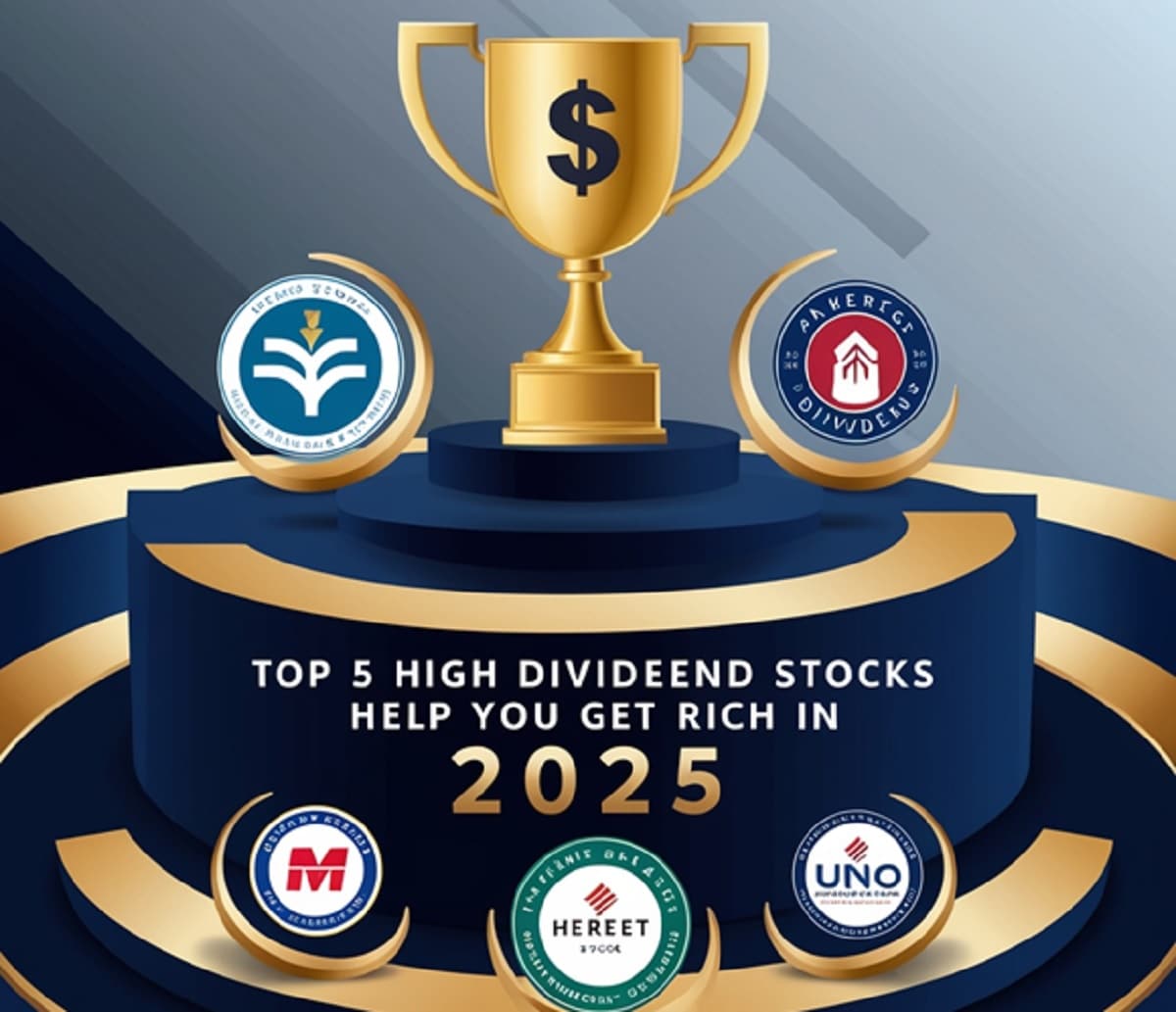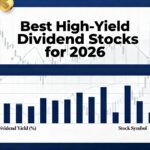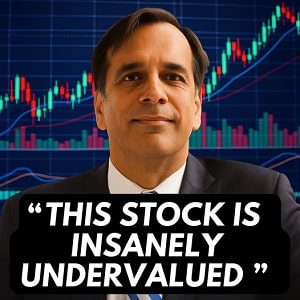Your struggle to enhance your income stands in the way of 2025’s target. Building wealth through passive income becomes possible with the investment of Top High Dividend Stocks.
Introduction
Many investors wonder about creating lasting net worth through 2025 while trying to avoid dangerous investment strategies because saving money in accounts yields minimal return during this period of rising inflation. The proven method for generating wealth appears to be comfortably relying on well-established high dividend stocks.
The income from high dividend stocks remains stable because market fluctuations do not affect these investments. Companies which distribute part of their earnings to investors through regular dividends enable you to enhance your income passive while capital values grow over time.
Below, we’ll dive into details including what defines superior dividend stocks while explaining all vital criteria for stock selection.
The following section will present our best 5 high dividend stock choices for 2025 because these assets can fortify your investment collection while building your net worth beyond mere chance.
What Are High Dividend Stocks?
The shares of companies which distribute sizable profits to shareholders as dividends offer payments above the standard market rate are known as high dividend stocks. Stockholders who maintain ownership of the company receive payments that are generally distributed during four equal quarterly periods.
All high-yield stocks do not make strong investments. For a stock to meet the definition of a high dividend the payment cannot be merely big but it needs sustainable earnings as well as consistent distribution and robust company fundamentals. The best high dividend stocks can be found in well-established industries such as utilities together with consumer staples and telecommunications and real estate investment trusts (REITs).
The following criteria defines a strong high dividend stock:
- Dividend Yield: Usually 3% or higher, but balanced with healthy earnings.
- Payout Ratio: The percentage of earnings paid as dividends—ideally below 75% to ensure stability.
- Long-Term Track Record: A consistent history of paying and increasing dividends.
- Financial Health: Low debt, stable cash flow, and strong balance sheets.
Income-focused investors who belong to groups like retirees and those who want to add to their income consider high dividend stocks as their preference. Young investors who plan to reinvest earnings through dividend programs will find these stocks equally advantageous for their long-term financial growth.
The Benefits of Investing in High Dividend Stocks
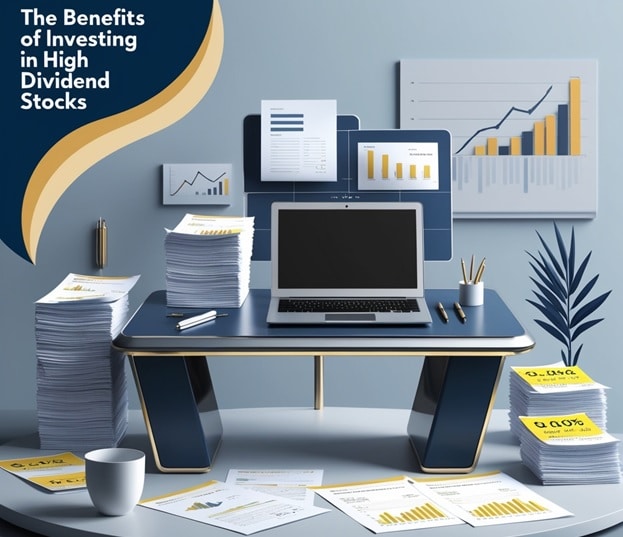
Selecting top high dividend stocks provides more than consistent income because they create a long-term improvement in your financial situation. The following key advantages of these stocks justify their position in a balanced investment portfolio:
Reliable Passive Income
Investors can access reliable cash flow via dividend stock payouts which occur either monthly or quarterly. Regular income flows are especially important during bear markets because capital growth rate decreases. Several investors receive dividends that deliver additional regular payments similar to their primary income.
Lower Volatility and Risk
Investors should consider established institutions which have established stable earnings and proven business methodologies because these companies pay dividends. These companies exhibit less market price instability which offers protection when economic conditions are uncertain. These are suitable investment options that deliver stability to investors focused on both traditional and enduring investments.
Dividend Reinvestment = Compounding Wealth
The repeated investment of dividend payments into additional company stocks causes compound growth. Continuous reinvestment of dividends results in enhanced total return which enables your investment capital to grow at a speed beyond non-dividend stocks. The strategy delivers optimal results to investors who have both a long period to invest and a young age.
Hedge Against Inflation
The value of cash buys less as prices increase but dividend-paying stock companies frequently increase their dividend payments throughout time. Due to their price-raising mechanisms dividend stocks create a powerful inflation defense that preserves your income value relative to consumer prices.
Total Return Enhancement
The returns of capital growth stand alone in growth stocks but dividend stocks deliver both price enhancement and dividend payments to investors. Investors who combine growth stocks with dividend stocks will achieve maximum total returns if they maintain a long-term ownership period.
During times of economic uncertainty the combination between lucrative dividends and stability and growth potential which high dividend stocks present enables them to be strong instruments for wealth generation.
Risks Involved with High Dividend Stocks
The use of top high dividend stocks as financial wealth generation tools presents risks to investors despite their potential effectiveness.
Making investments based solely on high yield without analysis ends in substandard choices. Every investor must be aware of these primary risks before starting any investment in dividend-paying stock markets:
Dividend Cuts or Suspensions
The obligation for a company to maintain dividend payments does not exist. Declining earnings alongside business financial challenges motivate management to cancel dividends. Your income suffers from such revenue reduction and the stock price faces a severe downward trend.
Yield Traps
Extremely high dividend payouts usually indicate an issue in the stock. Such a decline in stock price indicates fundamental operational issues within the company. The performance of yield traps deceives investors with high payments even though the underlying business lacks durability for extended periods.
Limited Growth Potential
Organizations which pay generous dividends tend to operate within industries which show minimal growth due to their maturity stage. Investors who receive steady income through these stocks experience limited upward movement of their stock value relative to growth stock performance. Young investors who pursue rapid growth find such investments to be ineffective for maximizing their long-term capital gains.
Interest Rate Sensitivity
Investments in dividend stocks suffer poor performance when interest rates rise especially among companies operating in utilities and real estate sectors. Rate increases in interest-bearing investment vehicles for investors lead to decreased prices for dividend stock securities.
Overconcentration Risk
Your investment is at risk when you distribute your capital among dividend stocks exclusively concentrated within one industry such as energy or real estate. Your investment strategy needs diversification to prevent taking risks that are not necessary.
Knowing dividend payout risks enables investors to select their dividend stock investments thoughtfully rather than stay away from them.
One should go beyond yield metrics to analyze business fundamentals and check cash flow performance together with dividend payment history.
Criteria for Selecting the Best High Dividend Stocks
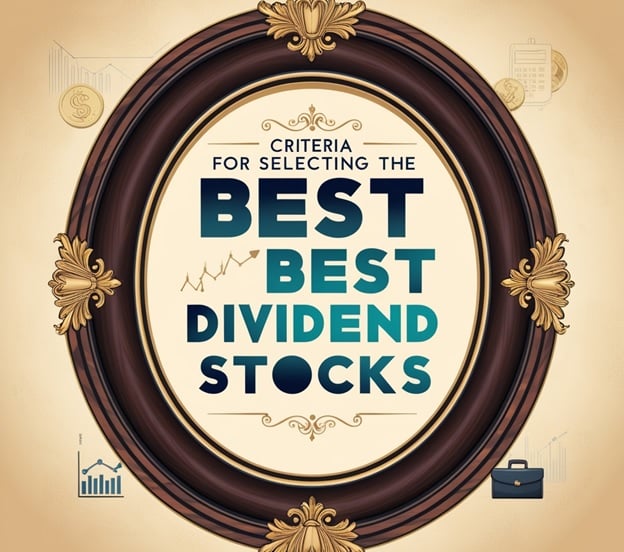
A differentiation exists between various dividend stocks. When seeking the top high dividend stocks for long-term success you must look past yield information alone. Use this structured list to determine if any dividend stock should be part of your investment portfolio:
Dividend Yield (But Not Too High)
Profits that generate between 3%–6% yearly are classified as sustainable and healthy for investors. Imperative examination of high dividend yields should occur because such distributions frequently indicate business problems or temporary excessive dividend distributions.
Payout Ratio
A company distributes its earnings through dividends as indicated by this percentage. The dividend payout ratio should stay below 75% because it demonstrates the company can pay dividends while maintaining sufficient funds to grow and reinvest in its business.
Dividend Growth History
The consistent payment history in dividend distribution from Dividend Aristocrats and Kings demonstrates strong financial position together with managerial excellence and investor-centric operations.
Financial Health & Free Cash Flow
A company needs streamlined balance sheets along with controlled debt levels and sufficient free cash flow to succeed. A company must generate steady cash flow from its operations rather than earnings because dividends depend entirely on cash availability for both maintenance and growth purposes.
Stable Business Model & Competitive Advantage
During market cycles recession-proof industries (such as utilities and healthcare along with consumer staples) with economic barriers to entry ensure consistent earnings and dividend payments.
Industry and Sector Outlook
Assess both current health and prospective development of the industry sector. Companies that operate in the REIT or energy sectors commonly provide high dividends but their earnings are vulnerable to market rate variations and petroleum price movements.
These analytical criteria function to distinguish between dependable high dividend stocks and unsafe or overpriced investments. The acquisition objective needs to deliver both long-term income stability together with continuous positive advancement in earnings.
Top 5 High Dividend Stocks for 2025
If you plan to accumulate sustainable wealth by 2025 our choice includes these five high dividend stocks that demonstrate reliable returns in stability, dividends and sector strength as well as superior long-term growth capacity.
1. Johnson & Johnson (JNJ)
- Dividend Yield: ~3.0%
- Sector: Healthcare
- Why It’s a Top Pick:
JNJ has operated as a Dividend King since 1965 with a track record of more than 60 years of consecutive dividend growth which demonstrates rock-solid fundamental strength combined with market volatility-resistant business operations. The global healthcare products of this company maintain consistent demand which supports it as a reliable long-term defensive investment.
2. Realty Income Corporation (O)
- Dividend Yield: ~5.5%
- Sector: Real Estate (REIT)
- Why It’s a Top Pick:
Since 1994 Realty Income has maintained its status as “The Monthly Dividend Company” while consecutively paying dividends every month for over 600 payments. The company generates solid steady cash flows through diverse commercial properties that exist under long-term lease agreements.
3. Verizon Communications Inc. (VZ)
- Dividend Yield: ~6.5%
- Sector: Telecommunications
- Why It’s a Top Pick:
The blue-chip stock yield of Verizon stands at one of the highest levels and shows exceptional reliability. The company has experienced slow capital expansion although it maintains its status as a core asset because it provides essential telecommunication services and plans to expand 5G technology.
4. Coca-Cola Co. (KO)
- Dividend Yield: ~3.2%
- Sector: Consumer Staples
- Why It’s a Top Pick:
Household consumers recognize Coca-Cola as one of the Dividend Kings that has been growing its dividends for numerous decades. Coca-Cola performs consistently because it maintains a global presence and branded goods while being able to adjust prices according to inflation.
5. Brookfield Infrastructure Partners (BIP)
- Dividend Yield: ~5.0%
- Sector: Infrastructure
- Why It’s a Top Pick:
The company pursues investments throughout the world within utilities along with transportation and energy sectors. With growing demand for infrastructure and a history of increasing dividends, BIP offers both high yield and future growth potential.
The selected high dividend stocks provide financial reliability and long-term strength which supports your path to wealth growth during 2025 and future years.
Tips for Building a High Dividend Portfolio
The creation of a balanced dividend portfolio requires more effort than choosing stocks with the highest returns. Top high dividend stocks should be utilized most effectively via an intelligent systematic approach. These guidelines provided by experts will aid you in developing a powerful dividend-paying investment portfolio for 2025.
Prioritize Quality Over Yield
Resistance to high-yield gain pursuits should be avoided. Investors should target proven financial organizations with steady earnings and reliable cash flow history and elevated dividend distribution patterns. Such businesses demonstrate stronger chances of keeping dividend payments going throughout economic recessions.
Diversify Across Sectors
It is unwise to concentrate your investments solely in one industry sector even when yields are attractive. Investors should distribute their funds across different sectors including healthcare and telecom with consumer goods and infrastructure to create a risk mitigation system.
Reinvest Dividends Automatically
You can enable dividend reinvestment through a DRIP or a broker-based automatic reinvestment system. Your portfolio grows faster through time due to the compounding effect as automatic reinvestment of dividends enables you to purchase more shares.
Monitor Financial Health Regularly
All dividend stocks regardless of their dividend strength have the potential to lose value. Regularly check dividend ratios together with earnings performance and assess corporate debt amounts. The free cash flow decreases or debt increase indicates upcoming potential dividend reduction by the company.
Stay Patient and Think Long-Term
Time is the crucial element that contains the real strength of dividend investing since compound growth works during long periods. Do not make financial decisions based on short-term price changes or market fluctuations that last only briefly. Follow your investment plan because the dividends will accumulate wealth on their own.
Watch for Tax Efficiency
The amount of tax you pay on your dividend income depends on your geographical location compared to the rules for capital gains taxes. Mature investors should keep dividend stocks in tax-favored retirement accounts like IRAs or ISAs because this arrangement results in increased post-tax earnings.
You can create a resilient portfolio which maximizes the full value of top high dividend stocks by using these principles to reduce common investment challenges.
How to Build a Balanced High Dividend Stock Portfolio
Achieving stable dividend revenue does not require absolute emphasis on dividend yield. Top dividend stock investors combine premier dividend yields with portfolio spread and safety strategies and long-term investment calculations. Here’s how to do it:
Diversification Strategies
Don’t put all your eggs in one basket. Even reliable dividend stocks can fall in value due to sector-specific risks.
- Diversify by Industry: Include companies from different sectors (e.g., telecom, healthcare, consumer goods, REITs).
- Diversify by Yield: Combine moderate yielders with growth potential (e.g., 2.5–3.5%) and stable high yielders (e.g., 5%+).
- Geographic Diversification: Consider adding international dividend stocks or ETFs to reduce country-specific risk.
This helps you protect your income and reduce volatility during market downturns.
Allocating Funds Between Dividend Stocks and Other Assets
Don’t ignore the importance of a well-rounded portfolio. While top high dividend stocks can provide regular income, over-concentration can limit growth or increase risk.
- Include Growth Stocks: These balance your income-producing assets with potential capital gains.
- Add Bonds or ETFs: For conservative investors, bonds offer stability and predictable income.
- Consider Cash or Short-Term Assets: For liquidity and flexibility during uncertain markets.
A good starting point:
- 60–70% in dividend-paying stocks
- 20–30% in growth or value stocks
- 10–20% in bonds or cash equivalents (adjusted for age/risk tolerance)
Conclusion: Can High Dividend Stocks Make You Rich in 2025?
The short answer? Yes—but only with the right strategy.
The right selection of top high dividend stocks supported by disciplined investing and diverse investment portfolio and patient strategy builds substantial wealth.
Strong income returns and growth potential in these stocks create an excellent investment opportunity for people who want to achieve financial independence in the long term. The path to success lies in choosing solid businesses while reusing dividend payments along with patients through market cycles.
High dividend stocks in 2025 provide investors with a special combination between secure defensive investment attributes and stable earnings streams even while economic doubts and rising inflation remain active market concerns. By following these guidelines you gain more than steady income since you build an enduring wealth base.
FAQ: High Dividend Stocks for Wealth Building in 2025
What are high dividend stocks?
High dividend stocks are shares of companies that pay out above-average dividends—typically 3% or higher—providing investors with consistent income.
Can high dividend stocks really help me build wealth in 2025?
Yes—when chosen wisely, high dividend stocks offer reliable income and capital appreciation, helping investors grow wealth steadily through compounding and reinvestment.
Are high dividend stocks safe during market volatility?
Generally, yes. Many high dividend stocks come from stable, mature sectors like utilities and consumer staples, which tend to be less volatile and more recession-resistant.
What are the risks of investing in high dividend stocks?
Risks include dividend cuts, yield traps (unsustainably high yields), limited growth, interest rate sensitivity, and lack of diversification if you over-concentrate in one sector.
How do I choose the best high dividend stocks?
Look for companies with sustainable yields (3–6%), a payout ratio below 75%, a history of growing dividends, strong cash flow, and solid financial health.
Should I reinvest my dividends?
Yes. Reinvesting dividends through a DRIP or brokerage service accelerates compounding and long-term portfolio growth.
How much of my portfolio should be in dividend stocks?
A balanced approach might be 60–70% in dividend stocks, with the rest in growth stocks, bonds, or cash to manage risk and maintain liquidity.
Are dividend stocks good for young investors too?
Absolutely. Young investors can benefit from reinvesting dividends over time, allowing compound growth to significantly increase long-term returns.
What sectors typically offer high dividend stocks?
Common sectors include healthcare, consumer staples, telecommunications, real estate (REITs), and infrastructure.
How can I avoid dividend yield traps?
Don’t chase extremely high yields. Instead, evaluate a company’s financial stability, earnings consistency, and dividend history to ensure the payout is sustainable.

